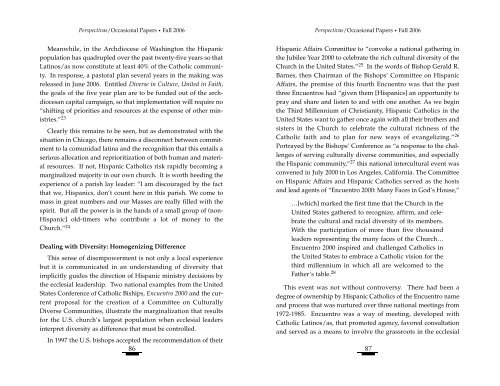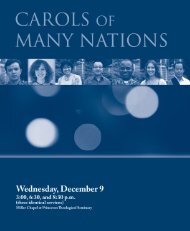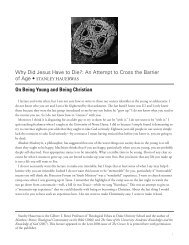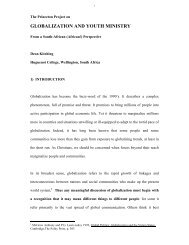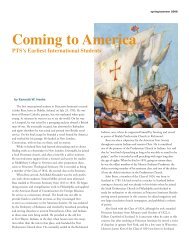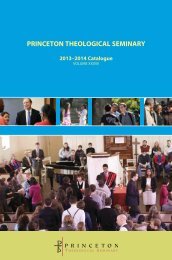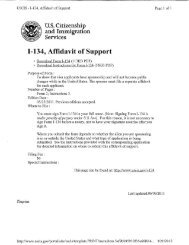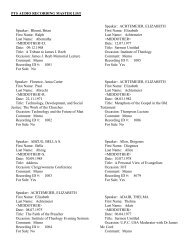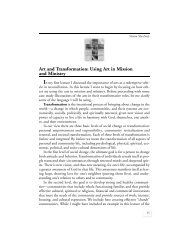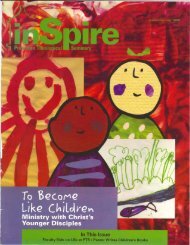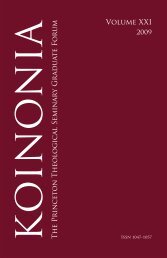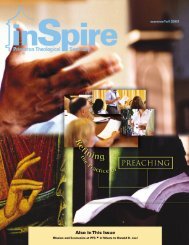P E R S P E C T I VAS - Princeton Theological Seminary
P E R S P E C T I VAS - Princeton Theological Seminary
P E R S P E C T I VAS - Princeton Theological Seminary
Create successful ePaper yourself
Turn your PDF publications into a flip-book with our unique Google optimized e-Paper software.
Perspectivas/Occasional Papers • Fall 2006Perspectivas/Occasional Papers • Fall 2006Meanwhile, in the Archdiocese of Washington the Hispanicpopulation has quadrupled over the past twenty-five years so thatLatinos/as now constitute at least 40% of the Catholic community.In response, a pastoral plan several years in the making wasreleased in June 2006. Entitled Diverse in Culture, United in Faith,the goals of the five year plan are to be funded out of the archdiocesancapital campaign, so that implementation will require no“shifting of priorities and resources at the expense of other ministries.”23Clearly this remains to be seen, but as demonstrated with thesituation in Chicago, there remains a disconnect between commitmentto la comunidad latina and the recognition that this entails aserious allocation and reprioritization of both human and materialresources. If not, Hispanic Catholics risk rapidly becoming amarginalized majority in our own church. It is worth heeding theexperience of a parish lay leader: “I am discouraged by the factthat we, Hispanics, don’t count here in this parish. We come tomass in great numbers and our Masses are really filled with thespirit. But all the power is in the hands of a small group of (non-Hispanic] old-timers who contribute a lot of money to theChurch.” 24Dealing with Diversity: Homogenizing DifferenceThis sense of disempowerment is not only a local experiencebut it is communicated in an understanding of diversity thatimplicitly guides the direction of Hispanic ministry decisions bythe ecclesial leadership. Two national examples from the UnitedStates Conference of Catholic Biships, Encuentro 2000 and the currentproposal for the creation of a Committee on CulturallyDiverse Communities, illustrate the marginalization that resultsfor the U.S. church’s largest population when ecclesial leadersinterpret diversity as difference that must be controlled.In 1997 the U.S. bishops accepted the recommendation of their86Hispanic Affairs Committee to “convoke a national gathering inthe Jubilee Year 2000 to celebrate the rich cultural diversity of theChurch in the United States.” 25 In the words of Bishop Gerald R.Barnes, then Chairman of the Bishops’ Committee on HispanicAffairs, the premise of this fourth Encuentro was that the pastthree Encuentros had “given them [Hispanics] an opportunity topray and share and listen to and with one another. As we beginthe Third Millennium of Christianity, Hispanic Catholics in theUnited States want to gather once again with all their brothers andsisters in the Church to celebrate the cultural richness of theCatholic faith and to plan for new ways of evangelizing.” 26Portrayed by the Bishops’ Conference as “a response to the challengesof serving culturally diverse communities, and especiallythe Hispanic community,” 27 this national intercultural event wasconvened in July 2000 in Los Angeles, California. The Committeeon Hispanic Affairs and Hispanic Catholics served as the hostsand lead agents of “Encuentro 2000: Many Faces in God’s House,”…[which] marked the first time that the Church in theUnited States gathered to recognize, affirm, and celebratethe cultural and racial diversity of its members.With the participation of more than five thousandleaders representing the many faces of the Church…Encuentro 2000 inspired and challenged Catholics inthe United States to embrace a Catholic vision for thethird millennium in which all are welcomed to theFather’s table. 28This event was not without controversy. There had been adegree of ownership by Hispanic Catholics of the Encuentro nameand process that was nurtured over three national meetings from1972-1985. Encuentro was a way of meeting, developed withCatholic Latinos/as, that promoted agency, favored consultationand served as a means to involve the grassroots in the ecclesial87


